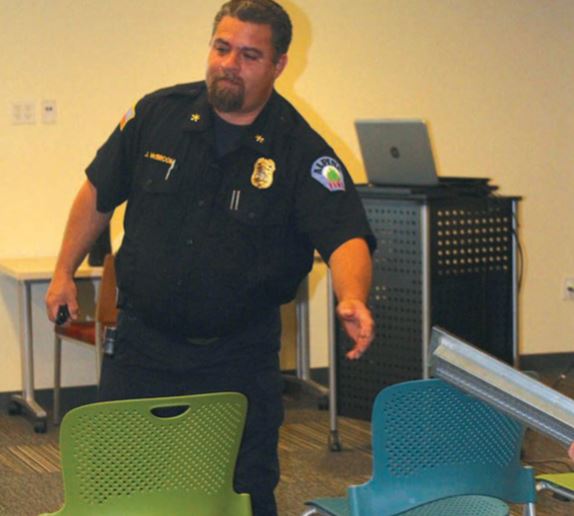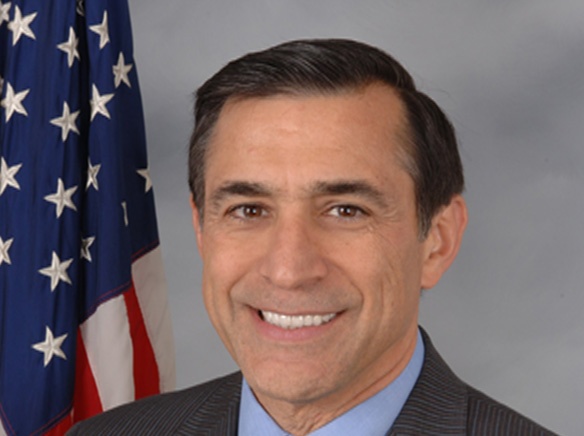
Alpine Fire Marshal Jason McBroom gave a Sept. 27 lecture about changes in defensible space codes, advice on how to be fire ready and more than a few warnings to local residents looking to harden their home against fire.
“People say ‘You want me to cut down my trees? No way.’ But, I can say scientifically that tree will be the reason a house burns down,” McBroom said.
The most effective thing people can do to protect their residence, he said to a handful of attendees at the Alpine library event, is create defensible space around their home. The fire marshal has issued a similar warning in previous lectures and offers free home consultations to help homeowners identify where they might need to harden their home.
The fire marshal illustrated his lecture with an image of a house that had three colored lines drawn around it: one circle around the house showed the new Zone 0 at five feet out from the home. The second line showed Zone 1 at five to 50 feet out from the home and the third line showed Zone 3 at 50 to 100 feet out from the home.
“As of January 1, 2021, zone 0 was created. This came about after the Camp fire in Northern California,” McBroom said.
The relatively new Zone 0 runs five feet in an outward direction from buildings, decks and other structures at risk of catching fire, McBroom said and should be transformed into an entirely noncombustible zone. The fire marshal advised residents to remove leaves and dead vegetation with potential to spread fire, and replace them with materials like pavers, gravel or rocks. Trees, shrubberies and other growth close to the house should be removed as well.
“Pretend I’m a tree, right? I’m eight feet away from the house so I’m good. Remember, trees should be trimmed of branches to a third of their height so if you have an 18 foot tree, that’s a six foot height to limb up. Now, let’s move closer to the house— at two feet away, the tree should be removed,” McBroom said.
Zone 1, he said, picks up where Zone 0 leaves off. It runs five to 50 feet from buildings and typically requires the most work to harden against fire. Vegetation should grow no higher than 18 inches, weeds should not be allowed to grow higher than six inches and trees should be pruned of their lower branches so any fire that does break out stands a better chance of passing underneath the tree canopy rather than spreading upward.
Zone 2 runs outward from Zone 1, runs 50 to 100 feet from buildings. There should be a ten foot separation between tree canopies and lower limbs should be pruned to create six feet of vertical clearance. Low growth should be trimmed to four inches high at the most.
Additionally, neighboring properties should be considered, regardless of property lines.
“Fire does not care about property lines,” McBroom said.
With a mischievous smile and a joking tone, McBroom claimed he was a master at the Pythagorean theorem in high school and explained the geometry behind a fire’s potential to spread up and out in a triangular pattern.
“During a wind driven fire, embers can travel up to five miles ahead of the fire. The embers drop like asteroids and as the fire begins to blow, the wind is pushing it forward,” the fire marshal said.
Those embers can easily pass through older air vents on homes, he said, and should be replaced.
“Crown Hills is a really good example: people redo their roofs there and see a layer of black dust where the roof almost burnt down in previous fires. The embers got in through the vents,” McBroom said.
Sunrise Powerlink Fire Mitigation Grants Program administrator Bonnie Burchill was on hand to pass out information on a vent replacement grant available to residents for 2023.
There are also grants available for defensible space and structure hardening through the program. More information on all three grants is available at www.sunrisepowerlinkgrants. com or at the grants office at 2241 W. Victoria Drive.
Additionally, Burchill said, road signs with large, reflective letters are available in two colors: green for regular homes and blue for those residences with a 10,000 gallon water tank stored on the property.
“The biggest takeaway is this: anything can burn,” McBroom said.













